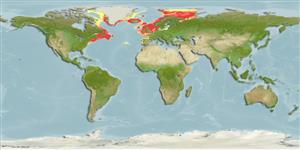Preferred temperature (Ref.
115969): 0.8 - 12.1, mean 7.8 (based on 1910 cells).
Índice de diversidade filogenética (Ref.
82804): PD
50 = 0.5938 [Uniqueness, from 0.5 = low to 2.0 = high].
Bayesian length-weight: a=0.00398 (0.00292 - 0.00543), b=3.19 (3.10 - 3.28), in cm Total Length, based on LWR estimates for this species (Ref.
93245).
Nível Trófico (Ref.
69278): 3.6 ±0.0 se; based on diet studies.
Resiliência (Ref.
120179): Baixo, tempo mínimo de duplicação da população 4,5 - 14 anos (K=0.04-0.1; tm=6-7; Fec=12,740-25,000).
Prior r = 0.40, 95% CL = 0.26 - 0.60, Based on 3 full stock assessments.
Fishing Vulnerability (Ref.
59153): High to very high vulnerability (69 of 100).
Climate Vulnerability (Ref.
125649): Moderate vulnerability (38 of 100).
